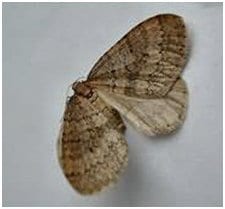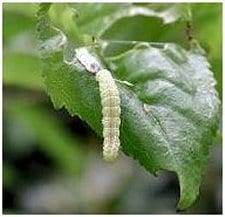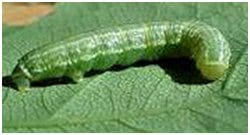by Carl Brodeur
Last November and December my phone was abuzz with reports from my clients in Southeastern Massachusetts, letting me know about little “whitish” moths flying around porch lights during the evening hours.

On several properties, as we raked leaves, I noticed moths swirling about at waist height and quickly returning to the ground. This is a sure sign of the presence of winter moth and my prediction is that that we will have a heavy infestation of these non-native caterpillars this spring. The male moth (shown in this photograph) is the one we see flying into the lights in the evening hours. He is looking to mate and is seeking a female who is virtually wingless.
The female walks up the stems of trees depositing her eggs wherever she can in a hap hazard manner inside cracks and crevices, under lichen and along branches. These tiny eggs will begin to hatch around 50 growing degree days which is  usually in early April. It appears that hatching typically occurs as buds swell on the host plant. The caterpillars then hang on a thin silk strand and get transported by the wind upward into the canopy of the tree, where they wriggle their way into a leaf or flower bud and begin their feast. To me the caterpillar at this point looks a lot like a green eye lash. The longer it takes for the bud to open the greater the damage they can do before a spray can be applied to stop their feeding. If the flowers are eaten then there will be no fruit. These non native caterpillars have no natural enemies so the damage they inflict can be tremendous. They feed on a variety of deciduous plants like blueberry, cherry, apple and crab-apple, maple, oak, etc. This photo shows the leaf damage caused by the winter moth caterpilla.
usually in early April. It appears that hatching typically occurs as buds swell on the host plant. The caterpillars then hang on a thin silk strand and get transported by the wind upward into the canopy of the tree, where they wriggle their way into a leaf or flower bud and begin their feast. To me the caterpillar at this point looks a lot like a green eye lash. The longer it takes for the bud to open the greater the damage they can do before a spray can be applied to stop their feeding. If the flowers are eaten then there will be no fruit. These non native caterpillars have no natural enemies so the damage they inflict can be tremendous. They feed on a variety of deciduous plants like blueberry, cherry, apple and crab-apple, maple, oak, etc. This photo shows the leaf damage caused by the winter moth caterpilla.
Controlling these caterpillars can be very challenging especially prior to their entering the free feeding stage, which is when the leaves unfold and begin growing. Horticultural oils can be applied prior to bud break in an attempt to kill off the eggs by smothering them. This is the most environmentally sound treatment and we have had very good results spraying oils on ornamental trees prior to flowering. The oil spray reduced the infestations and flowering occurred, much to our clients’ delight. It is much more difficult to have similar results on very large trees because it becomes harder to gain complete coverage.
Once the winter moth emerges from the bud and begins free feeding, then Bacillus thuringiensis (kurstaki), B.t.k. can  be used with great effectiveness and safety on the younger stages of caterpillar growth. B.t. is a natural occurring bacterium and it must be ingested to work. Only the leaf material that received a cover spray will have B.t. on it. New leaf growth will not be protected. Spinosad, derived from a soil based bacterium, is the next line of defense in combating larger size winter moth. Caution must be used around bees since it could be highly toxic to them until the Spinosad dries. At full maturity, the winter moth will be about 1 inch long, as shown in this photograph.
be used with great effectiveness and safety on the younger stages of caterpillar growth. B.t. is a natural occurring bacterium and it must be ingested to work. Only the leaf material that received a cover spray will have B.t. on it. New leaf growth will not be protected. Spinosad, derived from a soil based bacterium, is the next line of defense in combating larger size winter moth. Caution must be used around bees since it could be highly toxic to them until the Spinosad dries. At full maturity, the winter moth will be about 1 inch long, as shown in this photograph.
If trees have been seriously defoliated, watering will become critical to the plant’s survival. Care should be taken to properly water weekly during the dry part of our season. I recommend deep slow watering once per week. Do not use chemical based fertilizer as they are salts. My advice to properly care for your trees is to call a certified arborist and an Accredited Organic Land Care Professional in order to ensure that you are managing this pest in the most ecologically sound and responsible manner.
About the Author
Carl Brodeur is an ecological landcare professional with over 30 year experience as an arborist and a specialty in plant health care. He is co-owner and founder of Arborcare with Ropes ‘n Saddles in Massachusetts. He is an Accredited Organic Landcare Professional (NOFA), an active member of the Ecological Landscape Alliance (ELA), a Massachusetts and Rhode Island Certified Arborist, and is certified by the International Society of Arboriculture. He is also a Board member of the Taunton River Watershed Alliance.

